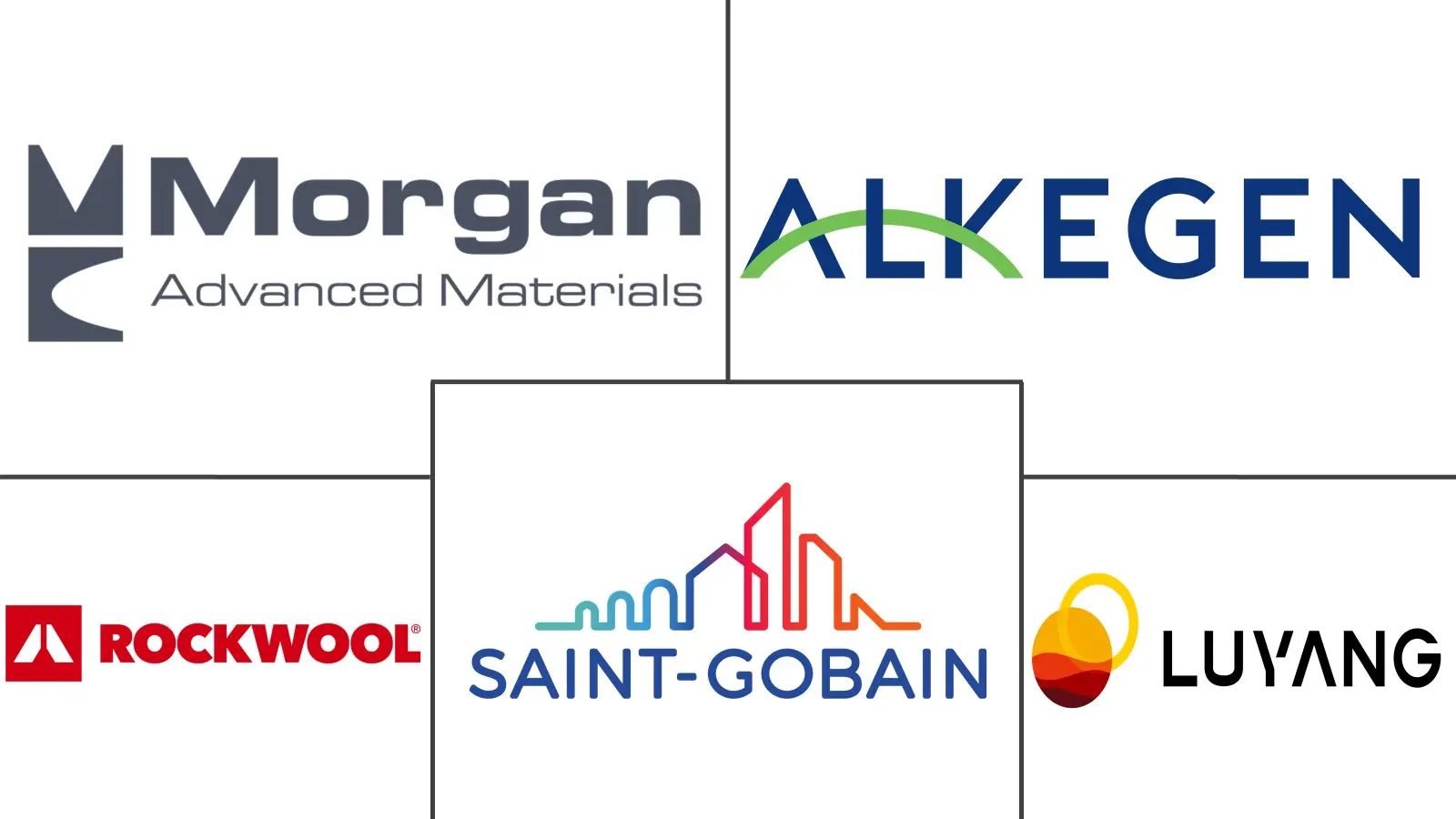High-temperature Insulation Materials Market Size and Share
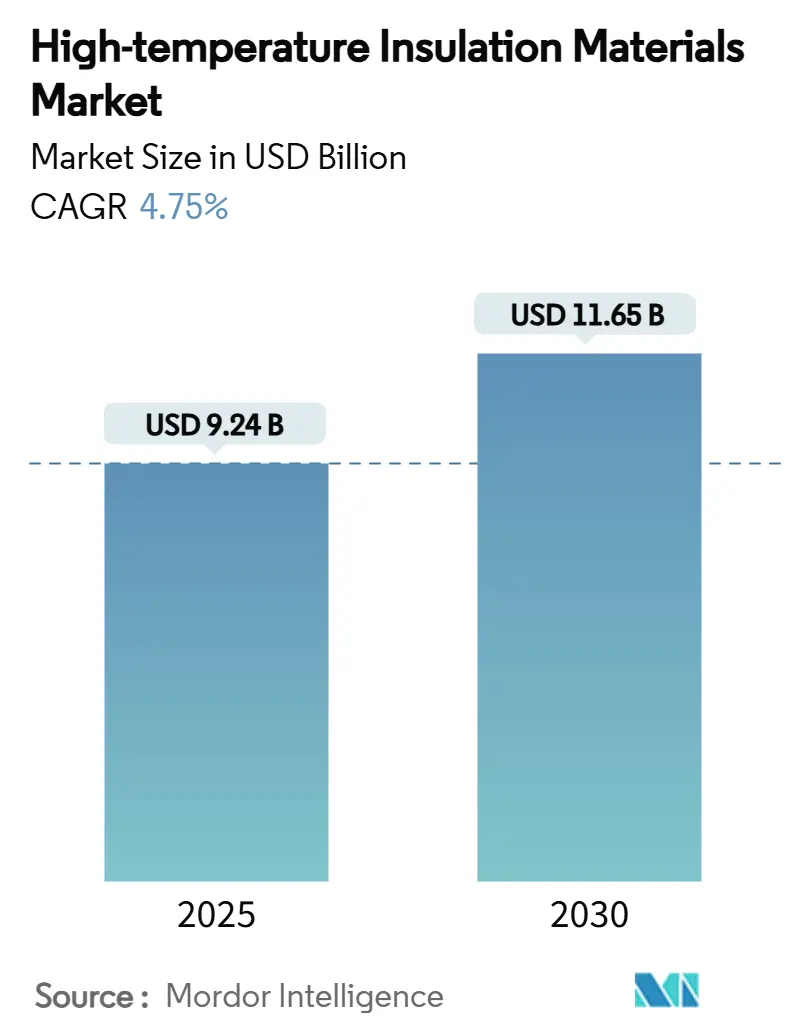
High-temperature Insulation Materials Market Analysis by Mordor Intelligence
The High-temperature Insulation Materials Market size is estimated at USD 9.24 Billion in 2025, and is expected to reach USD 11.65 Billion by 2030, at a CAGR of 4.75% during the forecast period (2025-2030). The current market size reflects steady demand growth as energy-intensive industries pursue operational efficiency and lower emissions. Tight building-energy codes, rapid petrochemical and metals capacity additions in Asia-Pacific, and expanding green hydrogen electrolyser installations form the backbone of demand. Manufacturers continue to prioritize non-combustible and low-biopersistent alternatives that satisfy stricter occupational exposure limits. At the same time, vertical integration strategies and regional capacity expansions are helping large suppliers shield themselves from raw-material price swings and logistics bottlenecks. While alumina, silica, and zirconia pricing remains volatile, the economic payback from lower fuel use and maintenance costs keeps adoption on an upward trajectory.
Key Report Takeaways
- By material type, ceramic fibre led with 56.19% of high-temperature insulation materials market share in 2024; other material types, including aerogel blankets and microporous panels, are projected to advance at 6.18% CAGR to 2030.
- By application, industrial equipment accounted for 43.42% share of the high-temperature insulation materials market size in 2024, while dedicated insulation applications are expanding at a 5.84% CAGR through 2030.
- By end-use industry, the petrochemicals segment held 30.64% revenue share in 2024; electrical and electronics is the fastest-growing end user at 5.94% CAGR to 2030.
- By geography, Asia-Pacific captured 47.51% of 2024 revenue and is forecast to post a 5.66% CAGR, the highest among all regions.
Global High-temperature Insulation Materials Market Trends and Insights
Drivers Impact Analysis
| Driver | (~) % Impact on CAGR Forecast | Geographic Relevance | Impact Timeline |
|---|---|---|---|
| Surging Demand for Energy-Efficient Industrial Furnaces | +1.2% | Global focus in Asia-Pacific and Europe | Medium term (2-4 years) |
| Tightening Building-Energy Codes Requiring High-Temperature Insulation | +0.8% | North America & EU, expanding to Asia-Pacific | Long term (≥ 4 years) |
| Rapid Capacity Build-Out in Asian Petro-Chem and Metal Sectors | +1.5% | Asia-Pacific core, spill-over to MEA | Short term (≤ 2 years) |
| Green-Hydrogen Electrolyser Adoption needs High Temperature Lining | +0.7% | Europe and North America, emerging Asia-Pacific | Long term (≥ 4 years) |
| Growing Lightweight, Durable Insulation Material Demand | +0.6% | Global | Medium term (2-4 years) |
| Source: Mordor Intelligence | |||
Surging Demand for Energy-Efficient Industrial Furnaces
Industrial furnace builders face stricter energy-performance rules under the 2024 International Energy Conservation Code, which lowered allowable heat loss and tightened air-leakage rates. Operators specify ceramic fibre blankets and microporous panels that endure 1,000°C service without compromising fuel economy. Typical energy savings approach 30% over legacy linings, improving payback despite higher capital cost. Integrating smart thermal management systems with advanced insulation materials enables predictive maintenance and optimized energy consumption, positioning high-temperature insulation as a critical component in Industry 4.0 transformation strategies. [1]International Code Council, “2024 International Energy Conservation Code,” iccsafe.org.
Tightening Building-Energy Codes Requiring High-Temperature Insulation
The same 2024 International Energy Conservation Code (IECC) revision also sharpened commercial building shell requirements, magnifying interest in continuous insulation and thermal-bridge mitigation. European Union Fit-for-55 directives demand complementary heat- and fire-resistant solutions in industrial facilities, increasingly favoring materials that combine thermal performance with fire safety, driving demand for non-combustible options like mineral wool and ceramic fiber systems. Building owners face escalating energy costs and carbon pricing mechanisms that make high-performance insulation economically attractive over building lifecycles. The convergence of energy efficiency mandates and fire safety requirements creates a sweet spot for high-temperature insulation materials that can address both regulatory imperatives simultaneously.
Rapid Capacity Build-Out in Asian Petro-Chem and Metal Sectors
Asia-Pacific's industrial expansion continues at an unprecedented scale, with China and India leading massive capacity additions in petrochemicals and steel production. China's heavy industry expansion, while supporting clean technology manufacturing, creates parallel demand for thermal management solutions in aluminum and steel production facilities. These assets rely on refractory linings that withstand intense thermal cycling while reducing fuel intensity. Specifications increasingly call for premium ceramic fibres and vacuum-formed shapes that shorten heat-up cycles and extend maintenance intervals. Middle-East complexes replicate these standards to meet export market emissions rules, further widening regional material demand.
Green-Hydrogen Electrolyser Adoption Needs High-Temperature Lining
The global transition to green hydrogen production creates new demand vectors for specialized high-temperature insulation materials. Solid oxide electrolysis cells (SOECs) operate at temperatures between 500-900°C, requiring advanced thermal management solutions that can maintain efficiency while preventing heat loss. High-temperature steam electrolysis systems offer 35% lower electricity requirements than conventional low-temperature electrolysis, making thermal insulation critical for economic viability. Manufacturers, therefore, incorporate refractory ceramic fibre boards and microporous tiles to retain heat while safeguarding personnel from surface temperatures. Thermal-energy-storage blocks in emerging heat batteries for renewables likewise use similar high-temperature insulation to store heat beyond 1,000°C, underscoring cross-sector synergy.
Restraints Impact Analysis
| Restraint | (~) % Impact on CAGR Forecast | Geographic Relevance | Impact Timeline |
|---|---|---|---|
| Occupational Exposure Limits on Synthetic Vitreous Fibres | -0.9% | Global; stricter in Europe & North America | Medium term (2-4 years) |
| Volatile Alumina and Silica Prices Squeeze Converter Margins | -0.6% | Global, affecting Asia-Pacific processing hubs | Short term (≤ 2 years) |
| Supply-Chain Risk for High-Purity Zirconia Precursors | -0.4% | Global; high China dependency | Long term (≥ 4 years) |
| Source: Mordor Intelligence | |||
Occupational Exposure Limits on Synthetic Vitreous Fibres
Regulatory authorities worldwide are tightening occupational exposure limits for synthetic vitreous fibers, with OSHA maintaining permissible exposure limits of 0.2 fibers per cubic centimeter for refractory ceramic fibers [2]Occupational Safety and Health Administration, “Safety and Health Topics: Refractory Ceramic Fibers,” osha.gov. The Health and Safety Executive in the UK has classified refractory ceramic fiber as a category 2 carcinogen, necessitating stringent control measures under COSHH regulations that increase handling costs and limit application flexibility. European legislation increasingly favors low-biopersistent alternatives, driving market share gains for alkaline earth silicate fibers despite their higher costs and slightly reduced temperature capabilities. The regulatory trend toward biosoluble fibers creates opportunities for innovative manufacturers while constraining traditional ceramic fiber applications. Compliance costs and liability concerns are pushing industrial users toward alternative materials, even when performance trade-offs exist. The long-term trajectory suggests continued regulatory pressure that will reshape the competitive landscape in favor of companies with strong low-biopersistent fiber portfolios.
Volatile Alumina and Silica Prices Squeeze Converter Margins
Raw material price volatility significantly impacts high-temperature insulation manufacturers, with alumina and silica representing 40-60% of production costs for ceramic fiber products. Zirconium dioxide prices have fluctuated between USD 3,755-6,067 per metric ton, creating margin pressure for manufacturers of premium refractory products. Supply chain disruptions and geopolitical tensions have exacerbated price volatility, with China's dominance in refractory mineral supply creating concentration risks for global manufacturers. The strategic nature of these materials means price fluctuations often reflect broader economic and political dynamics rather than pure supply-demand fundamentals. Manufacturers are responding through vertical integration strategies and long-term supply agreements, but smaller players face particular vulnerability to price spikes. The development of alternative raw material sources and recycling technologies offers potential mitigation, but implementation timelines extend beyond the immediate forecast period.
Segment Analysis
By Material Type: Ceramic Fibre Retains Leadership as Alternatives Scale
Ceramic fibre held 56.19% of 2024 revenue owing to its 1,260°C service limit, low density, and adaptability into blankets, modules, and boards. This leadership is anchored in asset-heavy industries, such as steel, non-ferrous metals, and petrochemicals, where downtime costs dwarf material prices. The high-temperature insulation materials market size for ceramic fibre is expected to post steady single-digit growth as new capacities in Asia-Pacific come on stream.
Other material types, such as aerogel composites and microporous panels, are the fastest-growing group at 6.18% CAGR. Weight-sensitive end uses value aerogels’ sub-0.020 W/m·K (Watt per metre Kelvin) conductivity combined with fiber reinforcement that boosts handling strength. Regulatory-driven migration to low-biopersistent chemistries accelerates alkaline earth silicate wool uptake, especially in Europe. Polycrystalline wool supports specialized duties above 1,500°C, while vacuum-formed shapes address complex geometries that would require costly on-site gunning or ramming. The high-temperature insulation materials industry continues to refine sintering additives and fiber diameters to balance shot content, strength, and thermal shock resistance.
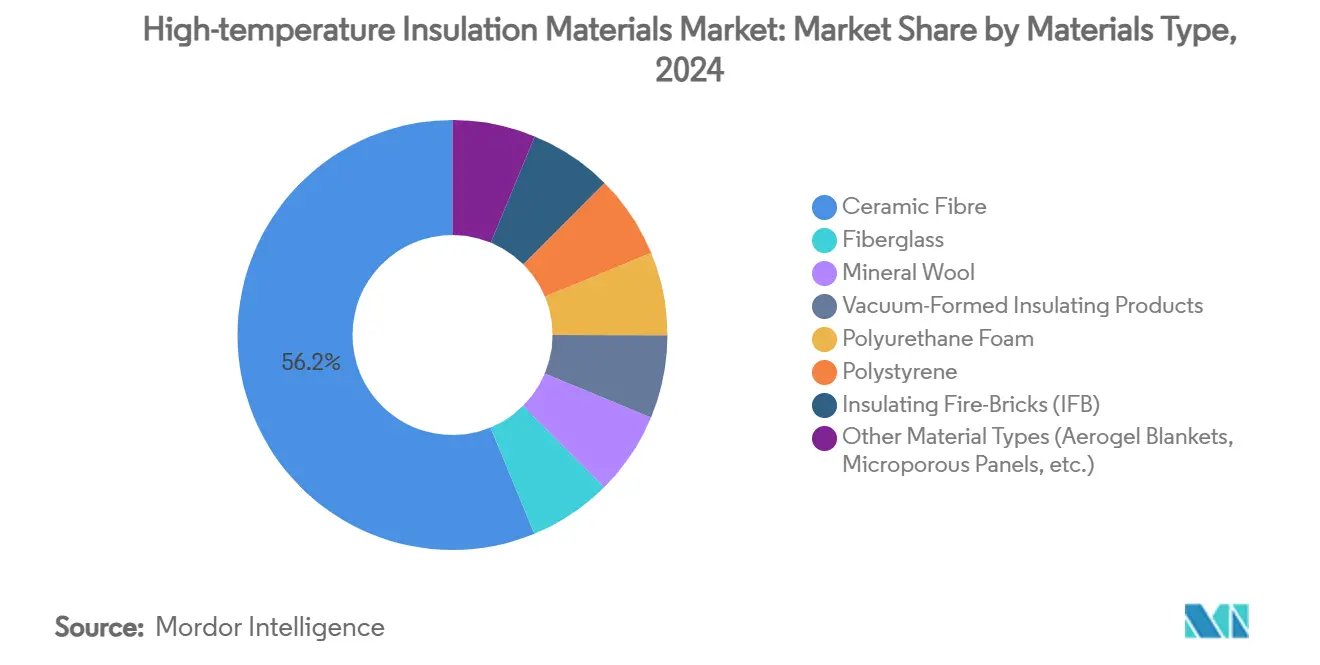
Note: Segment shares of all individual segments available upon report purchase
By Application: Industrial Equipment Dominates, Insulation Retrofits Accelerate
Industrial equipment accounted for 43.42% of 2024 revenue, reflecting the indispensability of reliable refractory linings in furnaces, kilns, and heaters. Process licensors impose exacting thermal-efficiency benchmarks; thus, furnace Original Equipment Manufacturers (OEMs) specify multilayer ceramic fibre and microporous systems to minimize shell temperatures and enhance operator safety. Equipment makers also integrate laminated insulation packs that simplify lining replacement during annual shutdowns, curbing unplanned outages.
Pure insulation retrofits represent the quickest-rising use case at 5.84% CAGR as facility owners respond to updated energy codes and carbon-pricing schemes. The high-temperature insulation materials market size for building retrofits is set to widen as governments fund industrial decarbonization grants. Thin, flexible blankets support tight spaces behind cladding panels while maintaining non-combustibility ratings. Fire-barrier assemblies combine mineral wool and ceramic fibre layers to meet insulation and flame-spread criteria. Cross-sector synergies emerge as technology proven in process equipment migrates into high-rise mechanical rooms and district-heating distribution lines.
By End-Use Industry: Petrochemicals Steady, Electronics Momentum Builds
Petrochemicals maintained a 30.64% share in 2024, underpinned by the sheer number of fired heaters, crackers, and reformers that require refractory upkeep. Operators mandate long campaigns between turnarounds, driving adoption of fiber modules that slash installation time and maintain uniform heat profiles. Upgraded steam crackers now pursue lower-carbon intensity, increasing demand for multilayer insulation packages that tolerate hydrogen-rich combustion.
Electrical and electronics applications, such as semiconductor fabs, lithium-ion gigafactories, and electric vehicle (EV) power electronics, are the fastest-growing at 5.94% CAGR. Cleanrooms demand particulate-free insulation, favoring low-dust ceramic fibre boards in high-temperature diffusion furnaces. Power chip sintering presses operate near 900°C, relying on stable insulation to prevent thermal runaway. The high-temperature insulation materials market share for electronics remains modest today, yet expands rapidly as device thermal loads climb and fabs proliferate across Asia-Pacific and North America.
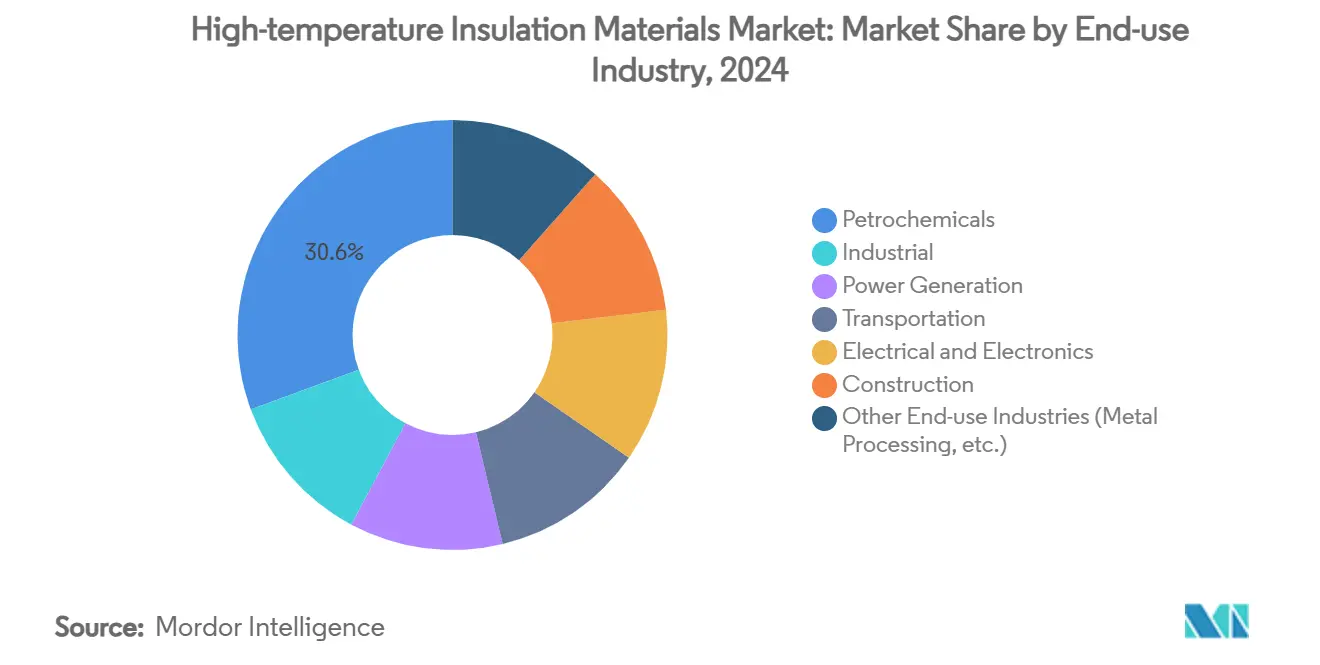
Note: Segment shares of all individual segments available upon report purchase
Geography Analysis
Asia-Pacific had a 47.51% market share in 2024 and is projected to advance at a 5.66% CAGR. China’s ongoing capacity additions in steel, aluminum, and chemicals sustain bulk demand, while India’s National Infrastructure Pipeline and expanding hydrogen plans reinforce long-term growth. Southeast Asian nations add petrochemical and renewables assets that likewise require refractory linings. Policymakers increasingly enforce energy-efficiency norms, shifting purchasing toward low-conductivity fibre modules and aerogels.
North America ranks second by value. Federal clean energy credits and state-level carbon caps make retrofit insulation economically attractive in refineries, liquidated natural gas (LNG) terminals, and pulp mills. The region’s reshoring of semiconductor and battery manufacturing raises consumption of ultra-clean insulation boards and fiber-reinforced aerogels. Robust industrial safety enforcement also accelerates adoption of alkaline earth silicate wool.
Europe remains technology-focused, leveraging its stringent environmental rules and carbon-border adjustments to champion low-biopersistent materials. European Union (EU) Green Deal investments spur renovation of existing industrial assets with multilayer linings that marry insulation and fire-containment. Innovative pilot projects in concentrated solar power and thermal energy storage adopt advanced ceramics, broadening application footprints.
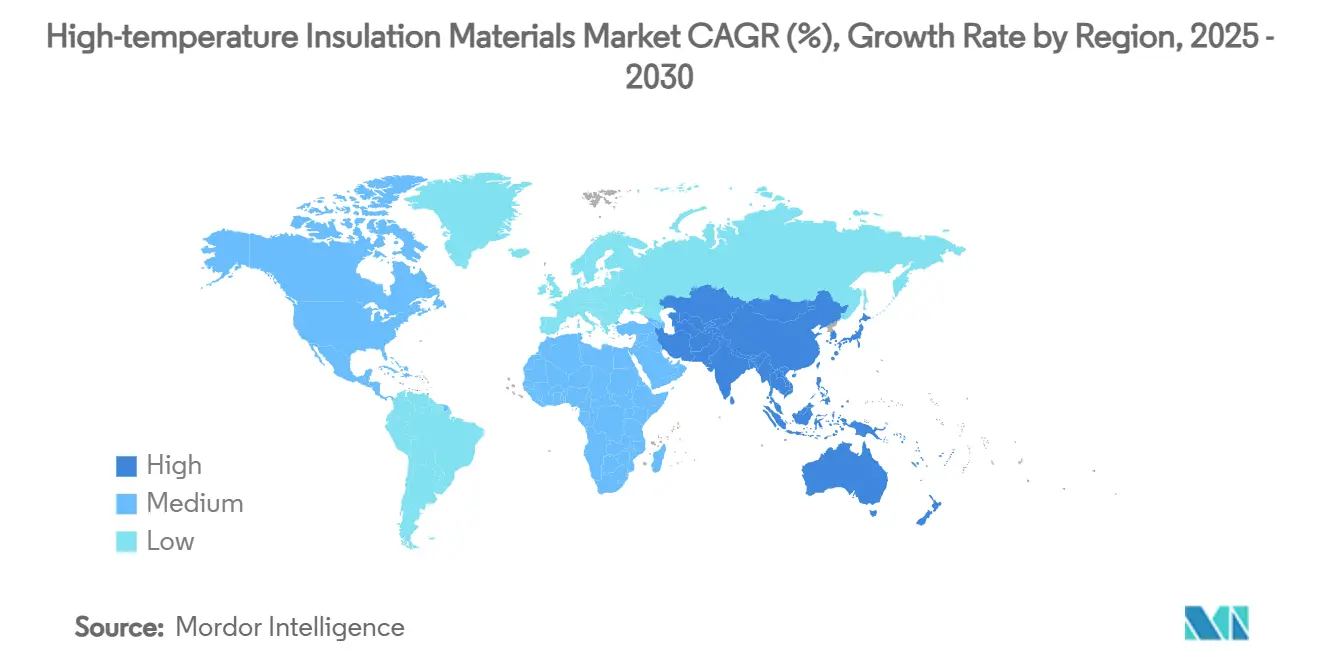
Competitive Landscape
The high-temperature insulation materials market exhibits moderate consolidation with established multinational corporations, such as Morgan Advanced Materials, Alkegen, Saint-Gobain, and Luyang Energy-saving Materials Co., Ltd., competing alongside specialized regional manufacturers. They devote significant R&D resources to super-wool and hybrid aerogel platforms, preparing for stricter exposure limits. Product differentiation revolves around fiber chemistry, shot content, and module anchoring designs that speed installation. Vendors also integrate digital monitoring infrared cameras, embedded thermocouples to showcase insulation performance, and support warranty programs. Partnerships with furnace Original Equipment Manufacturers (OEMs) and Engineering, Procurement, and Construction (EPC) contractors deepen preferred-supplier status, while vertical integration into alumina and silica mining helps limit raw-material risk.
High-temperature Insulation Materials Industry Leaders
-
Morgan Advanced Materials
-
Luyang Energy-saving Materials Co., Ltd.
-
Saint-Gobain
-
Alkegen
-
ROCKWOOL A/S
- *Disclaimer: Major Players sorted in no particular order
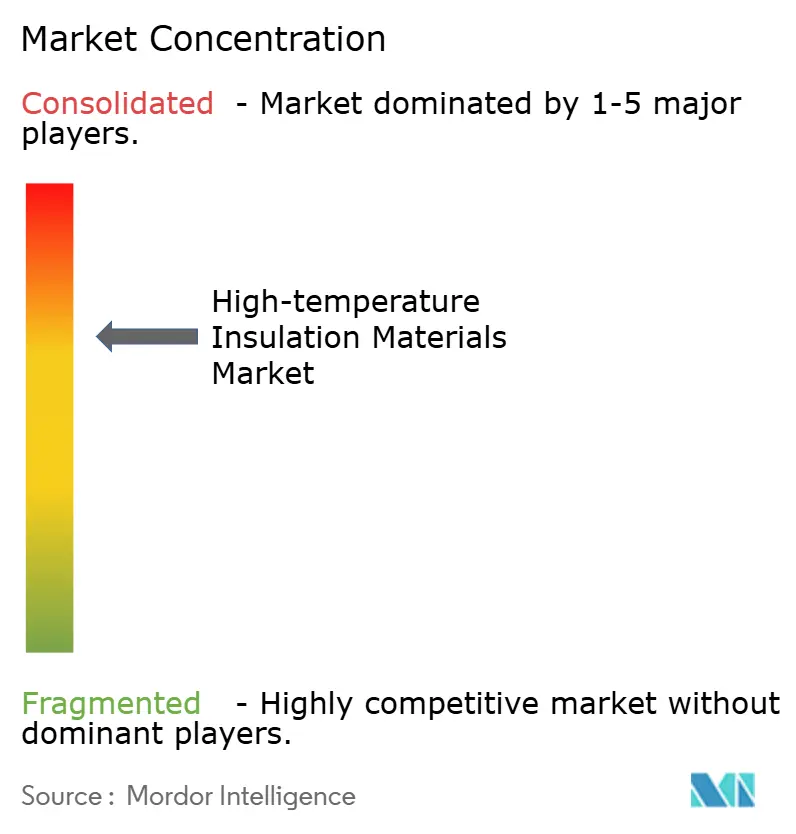
Recent Industry Developments
- October 2024: Carlisle Companies Inc. announced that it has agreed to acquire the expanded polystyrene (EPS) insulation segment of PFB Holdco, Inc., a portfolio company of the Riverside Company.
- October 2024: Knauf Insulation signed a deal with Texnopark, securing Texnopark's Rock Mineral Wool insulation division. This acquisition includes a state-of-the-art Tashkent, Uzbekistan plant boasting electric melting technology that significantly reduces CO2 emissions during production.
Global High-temperature Insulation Materials Market Report Scope
The high-temperature insulation materials market is segmented by material type, application, end-user industry, and geography. By material type, the market is segmented into fiberglass, mineral wool, vacuum-formed insulating products, polyurethane foam, polystyrene, insulating firebricks (IFB), and other material types. By application, the market is segmented into insulation, industrial equipment, and other applications. By end-user industry, the market is segmented into construction, transportation, electrical and electronics, power generation, petrochemicals, industrial, and other end-user industries. The report also covers the market size and forecasts for the high-temperature insulation materials market in 15 countries across major regions. For each segment, the market sizing and forecasts have been done on the basis of revenue (USD million).
| Fiberglass | |
| Ceramic Fibre | |
| Mineral Wool | Alkaline Earth Silicate (AES) |
| Aluminum Silicate Wool (ASW) or Refractory Ceramic Fibre (RCF) | |
| Polycrystalline Wool or Fibre (PCW) | |
| Long Fibre | |
| Vacuum-Formed Insulating Products | |
| Polyurethane Foam | |
| Polystyrene | |
| Insulating Fire-Bricks (IFB) | |
| Other Material Types (Aerogel Blankets, Microporous Panels, etc.) |
| Insulation |
| Industrial Eqipment |
| Other Applications (Building and Fire-Protection, etc.) |
| Petrochemicals |
| Industrial |
| Power Generation |
| Transportation |
| Electrical and Electronics |
| Construction |
| Other End-use Industries (Metal Processing, etc.) |
| Asia-Pacific | China |
| Japan | |
| India | |
| South Korea | |
| ASEAN Countries | |
| Rest of Asia-Pacific | |
| North America | United States |
| Canada | |
| Mexico | |
| Europe | Germany |
| United Kingdom | |
| France | |
| Italy | |
| Spain | |
| Russia | |
| NORDIC Countries | |
| Rest of Europe | |
| South America | Brazil |
| Argentina | |
| Rest of South America | |
| Middle East and Africa | Saudi Arabia |
| South Africa | |
| Rest of Middle East and Africa |
| By Material Type | Fiberglass | |
| Ceramic Fibre | ||
| Mineral Wool | Alkaline Earth Silicate (AES) | |
| Aluminum Silicate Wool (ASW) or Refractory Ceramic Fibre (RCF) | ||
| Polycrystalline Wool or Fibre (PCW) | ||
| Long Fibre | ||
| Vacuum-Formed Insulating Products | ||
| Polyurethane Foam | ||
| Polystyrene | ||
| Insulating Fire-Bricks (IFB) | ||
| Other Material Types (Aerogel Blankets, Microporous Panels, etc.) | ||
| By Application | Insulation | |
| Industrial Eqipment | ||
| Other Applications (Building and Fire-Protection, etc.) | ||
| By End-use Industry | Petrochemicals | |
| Industrial | ||
| Power Generation | ||
| Transportation | ||
| Electrical and Electronics | ||
| Construction | ||
| Other End-use Industries (Metal Processing, etc.) | ||
| By Geography | Asia-Pacific | China |
| Japan | ||
| India | ||
| South Korea | ||
| ASEAN Countries | ||
| Rest of Asia-Pacific | ||
| North America | United States | |
| Canada | ||
| Mexico | ||
| Europe | Germany | |
| United Kingdom | ||
| France | ||
| Italy | ||
| Spain | ||
| Russia | ||
| NORDIC Countries | ||
| Rest of Europe | ||
| South America | Brazil | |
| Argentina | ||
| Rest of South America | ||
| Middle East and Africa | Saudi Arabia | |
| South Africa | ||
| Rest of Middle East and Africa | ||
Key Questions Answered in the Report
What is the current value of the high-temperature insulation materials market?
The market is worth USD 9.24 billion in 2025 and is forecast to grow to USD 11.65 billion by 2030 at a 4.75% CAGR.
Which material type holds the largest share of the high-temperature insulation materials market?
Ceramic fibre leads with 56.19% revenue share in 2024 due to its versatility and temperature resistance.
Why is Asia-Pacific the dominant region in the high-temperature insulation materials market?
Massive petrochemical, metals, and electronics capacity expansions combined with stricter energy-efficiency mandates drive 47.51% of global demand and the fastest regional CAGR of 5.66%.
How are regulations influencing product development in this market?
Tighter occupational exposure limits are steering R&D toward low-biopersistent alkaline earth silicate fibres and fiber-reinforced aerogels that maintain performance while improving worker safety.
Page last updated on:
